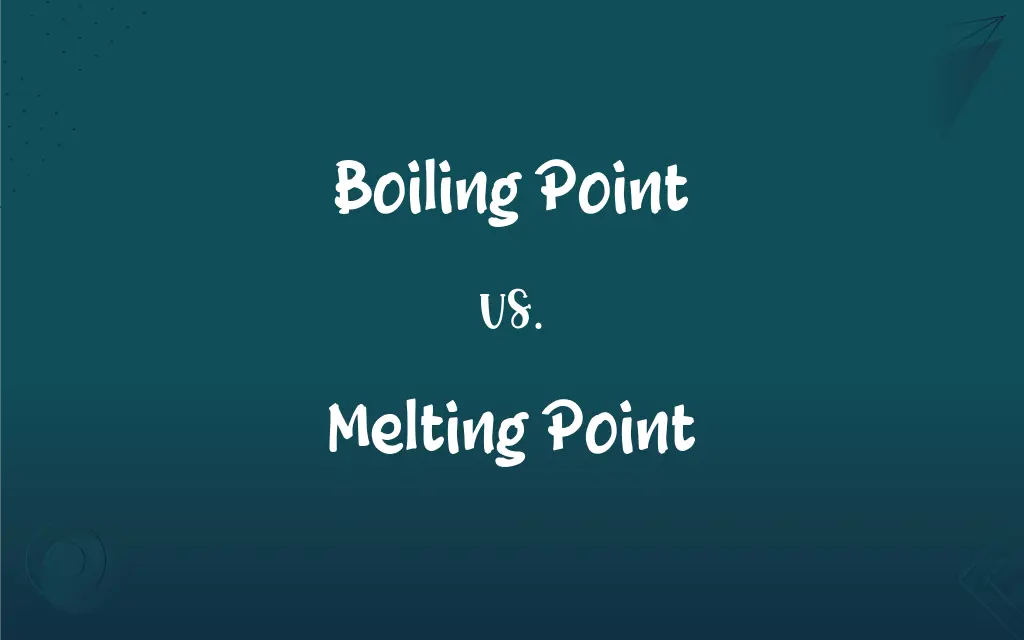Boiling Point vs. Melting Point: What's the Difference?
Edited by Aimie Carlson || By Harlon Moss || Updated on October 7, 2023
Boiling point is the temperature at which a liquid turns into a gas, while the melting point is the temperature at which a solid becomes a liquid.

Key Differences
In the context of physical chemistry and thermodynamics, the boiling point is an intrinsic property related to the transition of liquid to gas. Every substance has a specific boiling point under a defined atmospheric pressure, typically measured under standard atmospheric pressure. The boiling point can be influenced by atmospheric pressure, where higher elevations with lower pressure have lower boiling points. On the other hand, the melting point denotes the precise temperature at which a solid turns into a liquid.
Melting point is crucial in understanding the solid phase of matter. Substances become less ordered as they absorb heat and the molecular motion increases, prompting the transition from solid to liquid. The melting point is specifically the temperature at which this phase transition occurs under standard pressure. The melting point, unlike the boiling point, is not greatly affected by atmospheric pressure since the volume change during melting is relatively small.
The boiling point is inherently associated with the vaporization process, which is endothermic, meaning it absorbs heat. At the boiling point, the vapor pressure of a liquid equals the external pressure, and bubbles of vapor form within the liquid. A unique characteristic of boiling point is that the temperature remains constant during the entire boiling process despite the continuous input of heat.
In contrast, the melting point is linked to the heat of fusion, and similarly to boiling, temperature remains stable during the whole melting process. However, there are substances, such as amorphous solids and glasses, that do not have a precise melting point. For these materials, a range of temperatures, known as the melting point range, is provided to represent the transition from a rigid to a viscous or liquid state.
Both boiling point and melting point serve as critical reference points for phase transitions in various scientific and industrial applications. The boiling point is vital for distillation processes and the liquefaction of gases, while the melting point is crucial in metallurgy, material science, and manufacturing to ensure materials transition to a liquid phase in a controlled manner.
ADVERTISEMENT
Comparison Chart
Phase Transition
Liquid to Gas
Solid to Liquid
Temperature Stability
Remains constant while boiling
Remains constant while melting
Affected by Pressure
Yes, decreases with reduced pressure
No, negligibly affected by pressure
Example Substance
Water (100°C at 1atm)
Ice (0°C at 1atm)
Application
Distillation processes in chemistry
Metallurgy and material manufacturing
ADVERTISEMENT
Boiling Point and Melting Point Definitions
Boiling Point
Boiling point is subject to change under different atmospheric pressures.
The boiling point of water decreases as we ascend in altitude.
Melting Point
Melting points are crucial for determining the purity of a substance in chemistry.
A pure substance has a distinct and sharp melting point, utilized for identification in labs.
Boiling Point
The boiling point involves an endothermic process where heat is absorbed without changing temperature.
The boiling point remains consistent even as a liquid turns to vapor.
Melting Point
Amorphous solids and glasses may not have a sharp melting point but rather a range.
Glass transitions over a range of temperatures instead of having a fixed melting point.
Boiling Point
The boiling point is the temperature at which a substance transitions from a liquid to a gas.
Water has a boiling point of 100 degrees Celsius under normal atmospheric pressure.
Melting Point
The melting point signifies the temperature where a solid transforms into a liquid.
Ice has a melting point of 0 degrees Celsius.
Boiling Point
It's a specific thermal milestone where vapor pressure equals atmospheric pressure.
The boiling point is crucial in culinary processes like cooking pasta.
Melting Point
Melting point is usually less impacted by pressure changes than the boiling point.
The melting point of chocolate is crucial to confectionery manufacturing.
Boiling Point
It is an identifiable and repeatable point on a heating curve for pure substances.
The boiling point of ethanol is lower than that of water, causing it to evaporate sooner in a mixture.
Melting Point
The temperature remains stable during the melting process at the melting point.
The melting point of a substance is unchanged even when more heat is applied.
FAQs
Can the boiling point be altered?
Yes, altering the pressure conditions changes the boiling point of a substance.
Is melting point affected by pressure changes?
Melting point is generally not significantly influenced by pressure changes.
What is the boiling point?
The boiling point is the temperature at which a liquid becomes a gas.
What happens to molecular movement at the melting point?
At the melting point, molecules gain enough energy to break free from their rigid structure.
What is a notable difference between boiling and melting points?
The boiling point pertains to the transition from liquid to gas, while the melting point pertains to solid to liquid.
How does altitude affect boiling point?
Higher altitudes have lower atmospheric pressure, thus lowering the boiling point of substances.
What is the significance of the melting point in manufacturing?
The melting point is crucial to manipulate materials correctly in manufacturing processes.
How does impurity affect the boiling point?
Impurities typically elevate the boiling point of a substance.
How is the melting point defined?
The melting point is the temperature at which a solid transitions into a liquid.
Why does boiling occur?
Boiling occurs when the vapor pressure of a liquid equals the external pressure.
Can the boiling point be used to identify substances?
Yes, the boiling point is a characteristic property and can be used for identification.
Is melting point applicable to all solids?
Most solids have a melting point, but amorphous solids transition over a range of temperatures.
Are boiling and evaporating the same?
No, boiling occurs at a specific temperature, while evaporation can happen at any temperature.
What is a common use of melting points?
In laboratories, melting points are used to help determine a substance’s purity.
Can substances bypass the melting point and sublimate?
Yes, some substances, like dry ice, sublimate, going directly from solid to gas.
Do impurities impact the melting point?
Yes, impurities usually lower and broaden the melting point range of a substance.
What is the melting point of ice?
Ice melts at 0 degrees Celsius under standard atmospheric pressure.
Why does temperature remain constant at the boiling point?
The added heat energy goes into breaking intermolecular forces, not increasing temperature.
What happens to water at its boiling point of 100°C?
At 100°C, water undergoes a phase transition from liquid to gas.
How is melting point measured?
Melting point is measured using instruments like melting point apparatus in a laboratory.
About Author
Written by
Harlon MossHarlon is a seasoned quality moderator and accomplished content writer for Difference Wiki. An alumnus of the prestigious University of California, he earned his degree in Computer Science. Leveraging his academic background, Harlon brings a meticulous and informed perspective to his work, ensuring content accuracy and excellence.
Edited by
Aimie CarlsonAimie Carlson, holding a master's degree in English literature, is a fervent English language enthusiast. She lends her writing talents to Difference Wiki, a prominent website that specializes in comparisons, offering readers insightful analyses that both captivate and inform.






























































